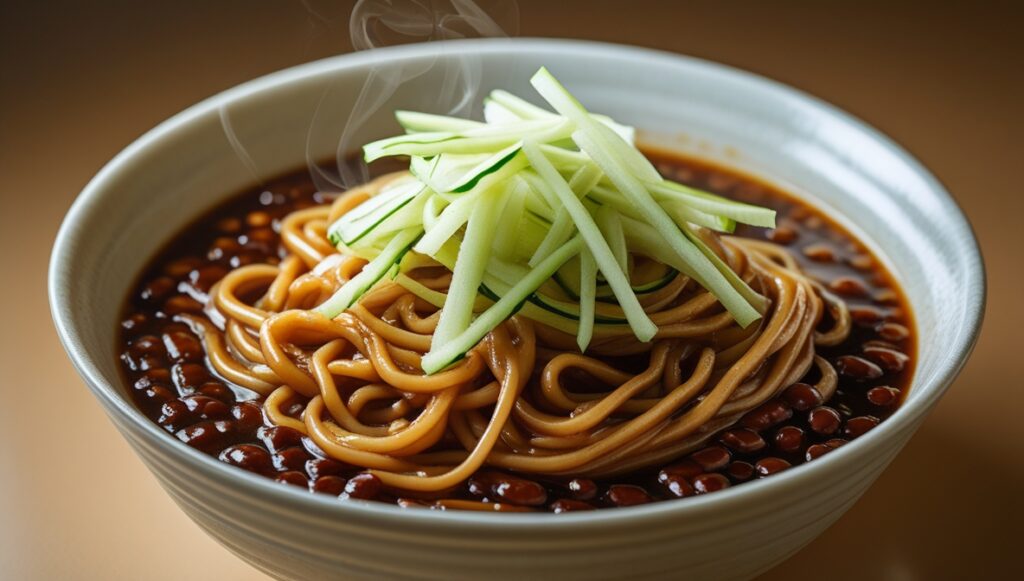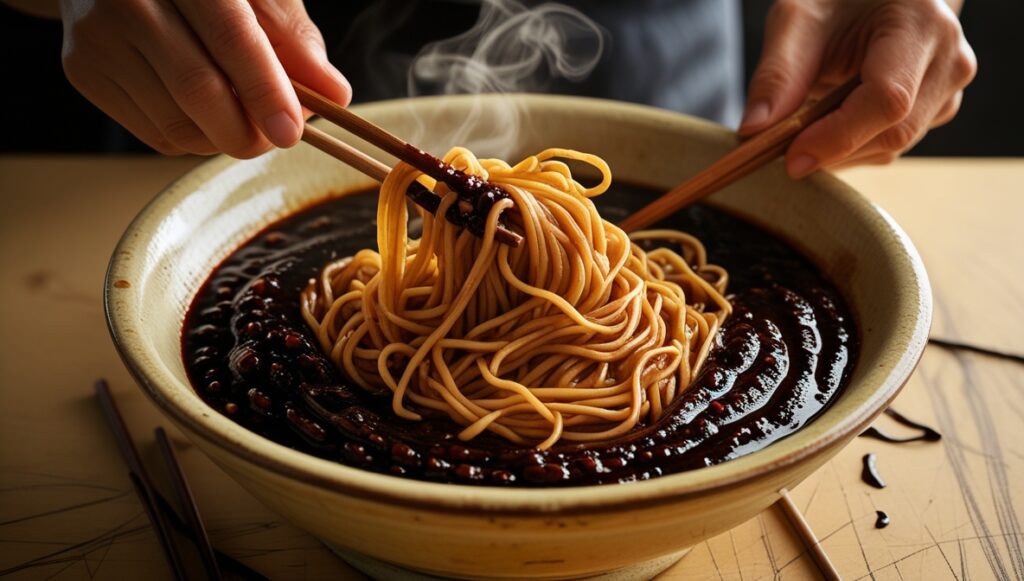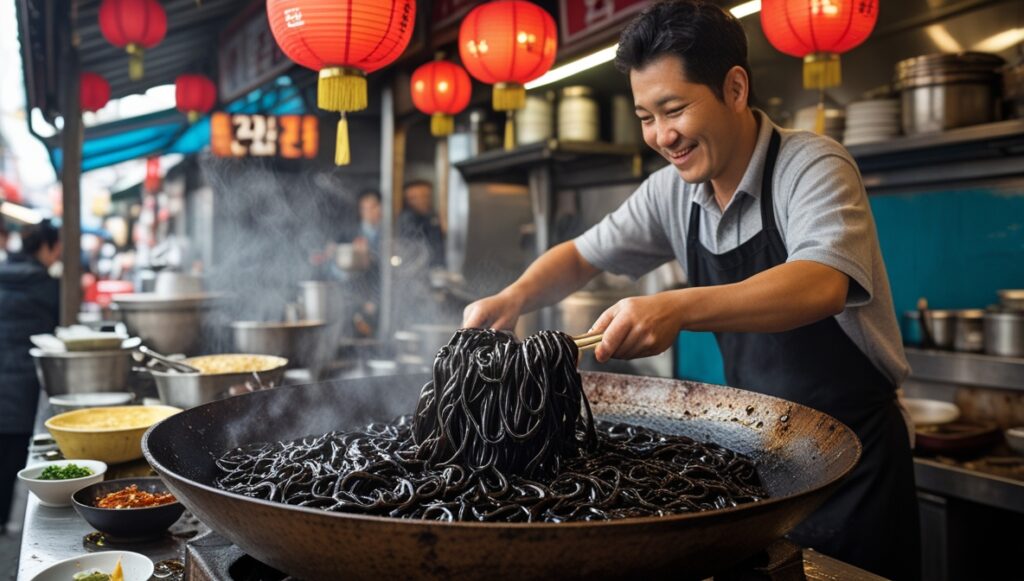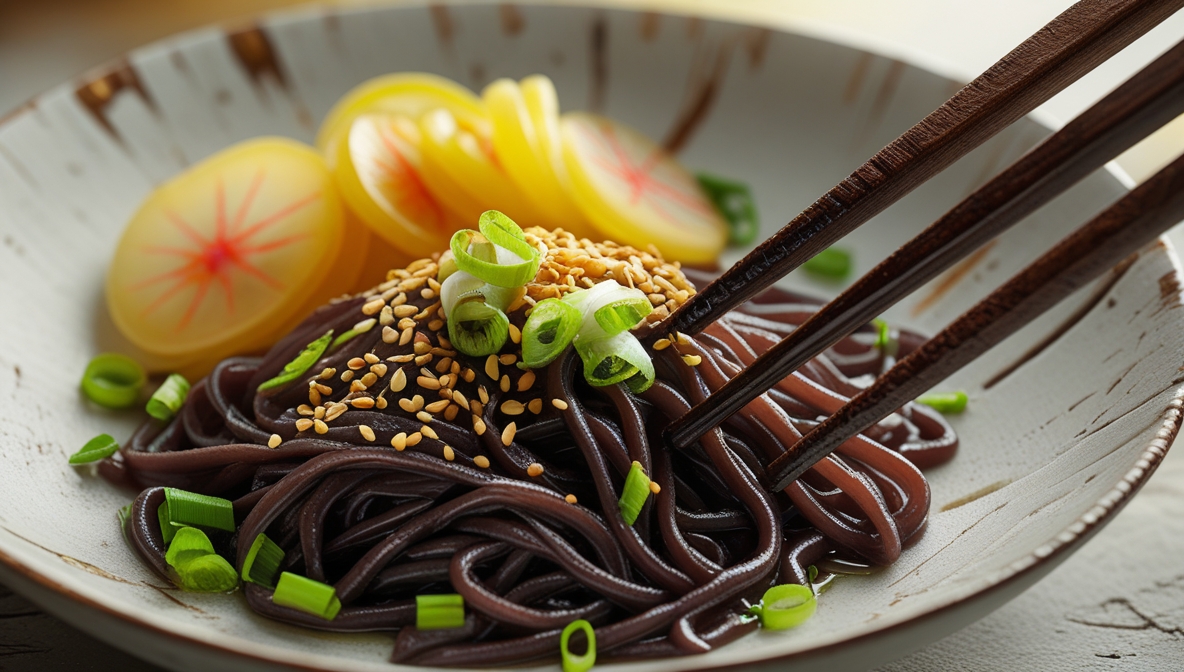Introduction
When it comes to Korean comfort food, Jjajangmyeon (Korean Black Bean Noodles) tops the list. With its thick black bean sauce, chewy noodles, and savory-sweet flavors, this dish holds a beloved place in the hearts (and stomachs) of South Koreans. It’s a go-to meal for quick takeout, late-night cravings, and even a popular choice on Korea’s unofficial “Singles Day” known as Black Day.
Why is Jjajangmyeon so loved? It’s satisfying, flavorful, affordable, and rooted in cultural tradition. Plus, who can resist those glossy black noodles?


History & Cultural Significance
Jjajangmyeon has Chinese roots, originally adapted from the Chinese dish “Zhajiangmian.” It was introduced to Korea in the late 19th century by Chinese immigrants in Incheon’s Chinatown.
-
Origin: Brought to Korea by Chinese merchants.
-
Transformation: Koreanized with a thicker, sweeter black bean sauce.
-
Cultural Role: Widely consumed during Black Day (April 14) by singles who didn’t receive gifts on Valentine’s or White Day.
-
Pop Culture: Frequently featured in K-Dramas, known as the ultimate Korean-Chinese comfort food.
Ingredients & Regional Variations
Key Ingredients:
-
Chunjang (black bean paste)
-
Pork or beef (can be substituted with tofu for vegetarians)
-
Onion, zucchini, cabbage, potato
-
Noodles (wheat-based, thick-cut)
-
Optional: sugar, oyster sauce, cornstarch
Regional Variations:
-
Gan-Jjajang: Dry version with no starch-thickened sauce.
-
Samseon Jjajang: Includes seafood like shrimp or squid.
-
Vegetarian Jjajangmyeon: Replaces meat with mushrooms or tofu.
Modern Adaptations:
-
Jjajangmyeon burgers, instant ramen versions, and vegan recipes are popular worldwide.
Cooking Process & Difficulty Level

Difficulty Level: Beginner to Intermediate.
Brief Step-by-Step Cooking Guide:
-
Dice meat and vegetables.
-
Stir-fry ingredients with oil until softened.
-
Add black bean paste and cook until aromatic.
-
Add water and simmer.
-
Thicken sauce with cornstarch.
-
Boil noodles separately and drain.
-
Pour sauce over noodles and garnish.
Tips: Use oyster sauce for deeper umami flavor. Serve immediately for best texture.
Where to Eat Jjajangmyeon in South Korea
-
Gonghwachun (Incheon Chinatown) – Claims to be the birthplace of Korean Jjajangmyeon.
-
Hong Kong Banjum 0410 – A popular chain by celebrity chef Baek Jong-won.
-
Chinatown in Seoul (Daerim-dong) – Home to authentic Korean-Chinese eateries.
-
Mokran (Seoul) – Upscale Chinese-Korean fusion with high-end Jjajangmyeon.
Pairing with Drinks & Side Dishes
Best Drinks:
-
Iced barley tea
-
Soju (for a spicy meal experience)
-
Light beer or Korean rice wine (makgeolli)
Perfect Side Dishes:
-
Danmuji (pickled yellow radish)
-
Kimchi
-
Fried dumplings (Gunmandu)
Fun Facts & Lesser-Known Trivia
-
Black Day: Jjajangmyeon is the official food for single Koreans on April 14.
-
K-Drama Fame: Frequently appears in Korean dramas and movies.
-
Record-Breaker: One of Korea’s most ordered delivery foods.
-
Celebrity Favorite: Stars like BTS and BLACKPINK have shown their love for it in interviews.
Health Benefits & Nutrition
Nutritional Highlights:
-
Carbohydrate-rich for energy
-
Moderate protein from meat or tofu
-
Fiber from veggies
Healthier Versions Available:
-
Vegan (tofu-based)
-
Gluten-free (using rice noodles)
-
Low-fat (less oil and lean meat)
How to Cook It at Home (Simple Recipe)
Ingredients:
-
200g pork or tofu
-
1 zucchini, diced
-
1 onion, diced
-
½ potato, diced
-
2 tbsp chunjang (black bean paste)
-
1 tsp sugar
-
1 cup water
-
1 tsp cornstarch + water
-
2 portions thick wheat noodles
Method:
-
Stir-fry pork in oil until browned.
-
Add veggies and cook until soft.
-
Stir in chunjang and sugar.
-
Add water and simmer.
-
Mix cornstarch with water and stir into the sauce.
-
Boil noodles separately.
-
Top noodles with sauce and serve with danmuji.
Cooking Tips:
-
Pre-fry chunjang with oil to remove bitterness.
-
Garnish with cucumber or boiled egg for color.
Global Influence & Fusion Cuisine
-
Found in Korean towns across the US, Canada, and Australia.
-
Inspired fusion dishes like Jjajang pizza, tacos, and pasta.
-
Instant versions sold internationally in Asian supermarkets.
Comparison with Similar Dishes
-
Jjajangmyeon (Korea) vs. Zhajiangmian (China): Sweeter, thicker sauce in Korean version.
-
Jjajangmyeon vs. Spaghetti Bolognese (Italy): Similar meat-based sauce, but Jjajangmyeon uses fermented black bean paste instead of tomato.
-
Jjajangmyeon vs. Japanese Udon in Curry Sauce: Both are comfort noodle dishes with rich sauces.

